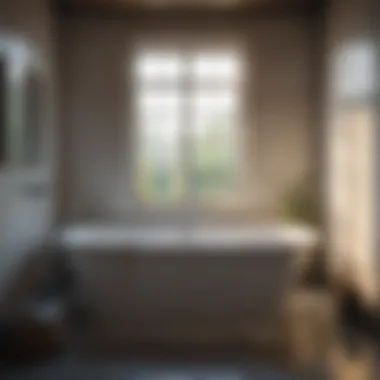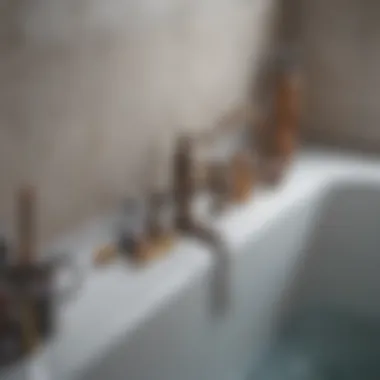Understanding Water Backups in Bathtubs and Toilets


Intro
Water backups in bathtubs and toilets represent a significant concern for homeowners. Understanding the reasons behind these malfunctions can help prevent potential damage and restore functionality efficiently. This topic touches on various factors, from plumbing design to maintenance practices. Such knowledge is essential for maintaining not only the plumbing systems but also the overall ambiance and function of a home.
Featured Homes
Architectural Highlights
Historic and modern homes alike often showcase unique plumbing challenges. In older houses, pipes may wear down over time, leading to blockages. In contrast, contemporary designs may unintentionally create complications due to poor layout. Different architectural styles dictate how plumbing interacts with wall structures and soil systems. Knowledge of these interactions can guide renovations or new builds.
Interior Design Themes
An interior’s aesthetic can heavily influence plumbing systems’ arrangement. For instance, an open concept design may require more complex piping solutions than traditional layouts. When water backup issues occur, they conflict with the design vision of a space. Homeowners must consider how to balance aesthetic appeal with functional practicality. Implementing concealed plumbing can enhance the overall look yet still necessitates regular check-ups.
Diagnostic Strategies
Identifying the root cause of a backup demands methodical assessment. Here are some common diagnostic strategies:
- Visual Inspection: Look for visible leaks or unusual water pooling around fixtures.
- Listening to Sounds: Gurgling noises may indicate an obstruction within the pipes.
- Smell: Foul odors can signal trapped debris or sewage backup.
Common Triggers
Many factors contribute to water backups. The most typical include:
- Clogged Drains: Hair, soap residue, and foreign objects frequently clog bathtub drains.
- Tree Roots: Roots can invade underground plumbing, leading to severe blockages.
- Sewage System Failure: Local sewer issues can back up water into home pipes.
By understanding these triggers, homeowners are better equipped to deal with plumbing issues proactively.
Preventive Measures
To maintain a functional plumbing system, preventive measures are crucial. Consider the following strategies:
- Regular Maintenance: Schedule professional inspections at least once a year.
- Proper Disposal: Avoid putting non-biodegradable materials down the drains.
- Drain Screens: Utilize screens to capture debris before it enters the plumbing.
The Impact on Home Functionality and Aesthetics
Water backups not only disrupt daily activities but also pose significant risks to home integrity. Rotting wood or mold growth can arise from unresolved plumbing issues. Furthermore, structural damage can diminish property value. Therefore, addressing these concerns aids in maintaining both functionality and aesthetics within a home.
Intro to Water Backup
Understanding the complex issue of water backups in bathtubs and toilets is essential for homeowners and design enthusiasts alike. As plumbing systems age or are subjected to various stresses, they become more susceptible to disruptions that lead to water backup. Recognizing the signs and implications of this issue can significantly affect a homeowner's quality of life and the overall value of a property.
Water backup refers to a situation where wastewater does not flow away from fixtures like bathtubs and toilets as intended. Instead, it reverses direction or remains stagnant within the system. This can lead to unsightly messes, unpleasant odors, and even health risks associated with standing water. Therefore, being informed about this problem is crucial not only for practical reasons but also for maintaining the overall aesthetic and function of one's home.
Moreover, addressing water backups promptly can save homeowners from more extensive damages and expensive repairs later on. Investing time and resources into understanding this topic is not just beneficial; it is a necessity for maintaining a safe and appealing living environment.
Definition of Water Backup
Water backup is defined as the failure of wastewater to properly exit through plumbing systems. When this happens, the water that should flow away remains in the bathtub or toilet, causing various issues. Backups can occur in a single fixture or can affect multiple drains at once, indicating a more serious plumbing problem within the system.
In most cases, these backups occur due to clogs, which can be caused by debris, grease, or tree roots infiltrating sewer lines. As pressure builds up, this barrier inhibits the flow of water, leading to overflow or stagnation within the plumbing fixtures. It’s worth noting that the type of plumbing materials and the age of the system can influence how and when backups occur.
Importance of Addressing Water Backup
Addressing water backups in a timely manner is crucial for several reasons. First, it has a direct impact on health and hygiene. Standing water can breed bacteria and other pathogens, posing health risks to inhabitants. This is particularly concerning if the backup includes sewage, which can carry harmful microorganisms.
Second, untreated water backup can lead to severe property damage. Prolonged exposure to excess moisture can compromise the integrity of structures, especially floors and walls. Mold growth is another serious consequence, which requires costly remediation.


Lastly, regular attention to plumbing health can prevent negative implications for property value. Buyers are often wary of homes with plumbing issues, and signs of previous backups can deter potential interest. Maintaining an awareness of this topic is therefore not just a matter of convenience; it is an investment in one's property.”
Understanding water backups is fundamental for effective home maintenance and maximizing your property's value.
Common Causes of Water Backups
Understanding the common causes of water backups is crucial for any homeowner. Knowing what can lead to these issues enables proactive measures, minimizing damage and cost. Water backups can create not only functional problems but also aesthetic and health concerns if not tackled promptly.
Clogs in Drainage Systems
Clogs are one of the primary reasons for water backups. They can form in various locations within piping systems, from drain pipes to the main sewer line. Common culprits include hair, soap residue, food particles, and other debris. As these materials accumulate, they obstruct the flow of water.
A slow-draining bathtub or toilet can often signal a developing blockage. Regular care and strategic usage can help human beings reduce these occurrences. Avoiding the disposition of unsuitable materials is vital. For instance, flushing items like wet wipes or placing excessive quantities of hair in drainage areas worsens the situation.
Issues with Ventilation
Ventilation plays a key role in a well-functioning drainage system. Inadequate venting can prevent wastewater from flowing correctly, leading to pressure changes that cause backups. Vent pipes allow air to enter the plumbing system, ensuring smooth movement of water.
When vents are blocked or improperly installed, it can create a vacuum effect. This may lead to water sitting stagnant in pipes, increasing the risk of backflow. Regular maintenance checks can identify these ventilation issues early, allowing for timely upgrades or repairs.
Pipe Damage and Corrosion
Aging or damaged pipes can be a hidden cause of water backups. Over time, pipes may corrode, develop leaks, or even collapse. These conditions often restrict water flow significantly. In old homes, pipes made from materials like galvanized steel or cast iron are more susceptible to corrosion. The integrity of pipes is paramount for proper drain functionality.
Periodic inspections can find signs of wear and tear. Homeowners should look for visible leaks or unusual damp spots in walls or ceilings. These signals indicate underlying issues, necessitating immediate professional evaluation.
Municipal Sewer Problems
Sometimes, backups stem from municipal systems. If the local sewer line faces blockages or overflow, it can lead to water backing up into individual homes. Heavy rain or melting snow can overwhelm municipal systems, particularly in areas with outdated infrastructure.
Homeowners can monitor alerts from local authorities related to sewer issues. Understanding the general state of local sewage systems can avail residents of necessary precautions during heavy weather events.
Awareness is vital. Recognizing the causes of backups can save homeowners from costly repairs.
Diagnosing Water Backup Issues
Diagnosing water backup issues is a crucial step in maintaining a home's plumbing health. Understanding the symptoms and the cause of backups can save homeowners significant time and money in the long run. By diagnosing these issues correctly, homeowners can implement preventive measures to avoid future complications. Furthermore, recognizing the signs early can help prevent extensive damage to property and enhance overall home functionality.
Observation of Symptoms
Slow Drainage
Slow drainage is one of the earliest and most common symptoms of water backup. It occurs when water takes longer than usual to flow down the drain. This condition can serve as a warning sign of a deeper issue within the plumbing system. The key characteristic of slow drainage is its gradual onset, which often leads homeowners to overlook the problem until it becomes severe.
The benefit of addressing slow drainage is that it allows for early intervention. The unique feature of this symptom is that it can help identify clogs before they evolve into more serious backflow or overflow issues. However, one disadvantage is that some homeowners may dismiss it as a minor inconvenience, delaying necessary action.
Overflowing Fixtures
Overflowing fixtures represent a significant indicator of plumbing failure. This phenomenon occurs when water fills a toilet or bathtub to the point of spilling over. The key characteristic of overflowing fixtures is the urgency it creates, prompting immediate attention to avoid further damage.
This symptom shines a light on existing blockages within the drainage system and highlights the pressing nature of water backup problems. One potential drawback of focusing solely on this symptom is that it may cause panic, overshadowing the need for thorough analysis of underlying causes.
Using Diagnostic Tools
Plumbing Snake
The plumbing snake is an essential tool in diagnosing drainage issues. This flexible auger is designed to clear clogs efficiently by reaching deep into pipes. Its key characteristic lies in its ability to navigate through the twists and turns of a plumbing system. As a popular choice for diagnosing backup issues, it provides homeowners and professionals alike with immediate results.


One unique feature of the plumbing snake is its effectiveness in breaking through stubborn blockages, making it a preferred option among many. However, its use requires some skill, and users could potentially damage pipes if mishandled, leading to more significant issues.
Video Inspection
Video inspection is a modern approach to diagnosing water backup problems. It involves using a small camera attached to a flexible cable, allowing for real-time visualization of the interior of pipes. Its key characteristic is the clarity it provides in identifying obstructions or damage.
This method is advantageous because it allows for precise diagnosis without invasive procedures. However, it may come with a higher cost compared to traditional methods, which can deter some homeowners from utilizing this beneficial tool.
Consulting Professionals
Consulting professionals should be the go-to option for serious water backup issues. Expertise from licensed plumbers can ensure that problems are diagnosed accurately, saving homeowners potentially costly mistakes from DIY attempts. Professionals can offer insights into systemic issues within the plumbing that may not be apparent to the average homeowner. This step is often critical, especially when symptoms become chronic or severely disruptive.
Preventive Measures
Preventive measures are essential in maintaining the integrity of your home's plumbing system. Water backups can lead to significant distress and costly repairs. By focusing on prevention, you minimize the risk of such issues arising in the first place. The benefits of being proactive are numerous. Regular preventive practices can enhance the longevity of your plumbing infrastructure, save you money on emergency repairs, and maintain the overall functionality of your home.
Regular Maintenance Practices
Routine Drain Cleaning
Routine drain cleaning is a fundamental aspect of preventive measures. It involves the systematic clearing of drains to remove buildup that can lead to clogs. This practice significantly contributes to preventing water backups in bathtubs and toilets. The key characteristic of routine drain cleaning is its ability to resolve minor build-up before it evolves into a substantial blockage.
This method is popular because it requires relatively low investment compared to other plumbing interventions. Regular cleaning is effective in preventing emergencies and is often straightforward for homeowners to carry out. For those who prefer professional help, many plumbing services offer scheduled cleaning at reasonable prices. However, if done improperly, it may lead to pipe damage or incomplete blockage removal.
Pipe Inspections
Pipe inspections are another critical preventive measure. These inspections involve checking the condition of pipes for any issues like corrosion or leaks that could precipitate a backup. The prominent feature of pipe inspections is their diagnostic approach. Through tools such as video cameras, professionals can assess the internal state of your plumbing.
Conducting regular pipe inspections is a prudent choice because it helps identify potential problems before they escalate. Uncovering issues early on can save homeowners considerable amounts in damages and repairs. However, one challenge with pipe inspections is that they may involve additional costs, especially if repairs are necessary after the inspection.
Educating Household Members
Proper Waste Disposal
Educating household members about proper waste disposal is invaluable. This involves not putting inappropriate items in toilets or sinks that can create backups. The emphasis on proper waste disposal is crucial because many household backups stem from avoidable mistakes.
Highlighting the importance of this practice can significantly contribute to the overall goal of preventing water backups. It's beneficial because it fosters awareness among all family members, ensuring everyone knows the correct protocols. If ignored, improper disposal can lead to serious plumbing failures.
Avoiding Chemical Products
Avoiding chemical products for drain maintenance is a growing recommendation among plumbing professionals. Many chemical cleaners can corrode pipes over time and lead to failures. The notable aspect of avoiding these products is the shift towards safer alternatives that maintain plumbing health.
This choice supports the overall goal of protecting home plumbing systems while being more environmentally friendly. While some may find chemical products effective for immediate issues, their long-term ramifications can outweigh short-term benefits. Thus, educating household members on alternatives, such as natural cleaners or regular maintenance, is a viable practical step.
Impact on Home Aesthetics and Functionality
Water backups in bathtubs and toilets can have significant repercussions on both the aesthetics and functionality of a home. Not only can they lead to unsightly messes, but the implications extend beyond mere appearance. Understanding these impacts is crucial, especially for homeowners who value both the beauty and practicality of their living spaces.
Damage to Interiors
When water begins to back up, it often manifests as leaks or overflows. This can cause serious damage to interiors, including floors, walls, and fixtures. For instance, water can seep into flooring materials, weakening them over time and potentially leading to mold growth. Cabinets beneath sinks and bathtubs can also suffer water damage, leading to expensive repairs.
Important aspects to consider include:
- Water Stains: Unsightly marks can develop on walls and ceilings, creating a perception of neglect.
- Mold Growth: Stagnant water can encourage mold, affecting not just aesthetics but also health.
- Structural Damage: Prolonged exposure to water may compromise the structural integrity of your home's materials.
Ensuring that homes remain safe and appealing requires vigilance in addressing water backup issues proactively.


Implications for Home Value
The overall value of a home is not solely determined by its aesthetic appeal; functionality plays an equally pivotal role. Frequent water backups and the resulting damage can deter potential buyers, affecting resale value. Homes that show signs of water damage may command lower offers, as buyers may factor in the cost of repairs.
Key factors influencing home value include:
- Market Perception: Homes associated with plumbing issues can be viewed negatively, impacting buyer interest.
- Cost of Repair: Buyers may discount offers based on anticipated repairs for underlying issues related to backups.
- Long-term Investments: Homes that remain functional and aesthetically pleasing tend to appreciate more over time.
Remediating Water Backup Issues
Addressing water backup issues promptly is essential for maintaining both the functionality and aesthetics of your home. Water that backs up in bathtubs and toilets can not only be an inconvenience but also a source of potential damage to your property. Remediation involves a two-pronged approach: immediate actions to mitigate damage and long-term solutions to prevent recurrence. This section will outline the importance of taking decisive actions to remedy water backups and the potential benefits or considerations involved.
Immediate Actions to Take
Shutting Off Water Supply
One of the first actions to take during a water backup situation is shutting off the water supply. This action stops the influx of water, preventing further damage to your home's structure. It is a simple yet effective solution that can spare homeowners from costly repairs. Key characteristic of this action is its immediate effect on halting water flow.
In an emergency, getting to the main shutoff valve — usually located in the basement or outside your home — can be crucial. By doing so, you gain control over the situation. A distinct advantage of this method is that it can be executed quickly, even if you are not highly familiar with plumbing.
However, one disadvantage is that while it prevents more water from entering, it does not solve the existing backup. Property owners must then follow up with additional steps to manage any immediate water damage. It’s wise to familiarize oneself with the valve locations ahead of time to act swiftly when needed.
Using Wet Vacuums
After shutting off the water supply, using wet vacuums can be highly beneficial. Wet vacuums are designed to remove excess water quickly, thus minimizing further damage to flooring or cabinetry. They can handle significant amounts of water, making them effective for larger spills. Their unique feature lies in their ability to suction water from various surfaces.
Wet vacuums are a popular choice due to their accessibility; many homeowners can rent or purchase these devices easily. Furthermore, they are often user-friendly, requiring minimal instructions to operate. However, while they can remove standing water, they may not address underlying issues that caused the backup in the first place, such as plumbing clogs or damaged pipes.
Long-Term Solutions
Repairing Pipes
Addressing any underlying plumbing issues, such as repairing damaged pipes, is critical for long-term remediation. Damaged pipes can be single points of failure leading to recurring backups. When pipes are not functioning correctly, it increases the likelihood of water backups, creating a cycle of problems.
The key characteristic of repairing pipes is the potential to provide a permanent solution. When done correctly, this repair stops the disruption and leads to more reliable plumbing systems. Investing time and resources in professional plumbing services can yield high returns by preventing future backup situations.
However, repairs must be conducted by qualified professionals to assure quality. There might be short-term inconveniences involved such as potential costs and the need for temporary relocation during repairs, but this effort results in lasting benefits.
Installing Backflow Preventers
Installing backflow preventers is another key long-term solution to mitigate the risks of water backups. These devices prevent wastewater from flowing back into your home through your drainage system. They act as a barrier, ensuring that drains remain clear and channel waste properly, reducing the chances of backups.
The unique feature of backflow preventers is their ability to automatically close when backflow occurs, making them an effective and passive defense mechanism. This makes them a beneficial choice for many homeowners looking to enhance their plumbing system's reliability.
Despite the advantages, there are some considerations. Installing backflow preventers usually requires professional assistance and may add to the initial plumbing investment. Homeowners must also ensure that these systems comply with local codes, as improper installations can lead to further complications.
In summary, remediating water backups involves both immediate and long-term actions that are critical to restoring home functionality and aesthetics.
Finale
The subject of water backups in bathtubs and toilets holds significant relevance for homeowners and real estate enthusiasts. Understanding the risks and implications can help prevent substantial damage and maintain property value. Water backups, if ignored, can lead to unsanitary conditions, structural damage, and costly repairs. Thus, a thorough grasp of this topic equips property owners with the knowledge needed to react swiftly and effectively to plumbing issues.
Summary of Key Points
- Common Causes: Water backups generally occur due to blockages or damaged pipes. Knowing the common culprits, such as clogs, pipe corrosion, and sewer problems, allows for better prevention.
- Diagnosis: Observing symptoms like slow drainage or overflowing fixtures is crucial. Additionally, using diagnostic tools, like plumbing snakes or video inspections, aids in identifying the problem more accurately.
- Remediation: Taking immediate actions like shutting off the water supply can mitigate damage. Long-term solutions involve repairing pipes and installing backflow preventers.
A home with a well-functioning plumbing system ensures comfort and safety for its occupants.
The Importance of Proactive Measures
Proactive measures are vital in managing potential water backup issues. Regular maintenance practices such as routine drain cleaning and pipe inspections serve as preemptive strategies against clogs and pipe degradation. Training household members on proper waste disposal is equally crucial. Misuse of toilets and sinks can escalate minor issues into significant problems.
By understanding the consequences of neglect, homeowners can prioritize plumbing upkeep. Such diligence not only saves money in the long run, but also preserves the home’s aesthetic integrity. Water backups can lead to unpleasant odors, unpleasant sights, and unexpected home repairs. Therefore, being proactive forms a crucial line of defense against the upheavals caused by water stagnation in bathtubs and toilets.







